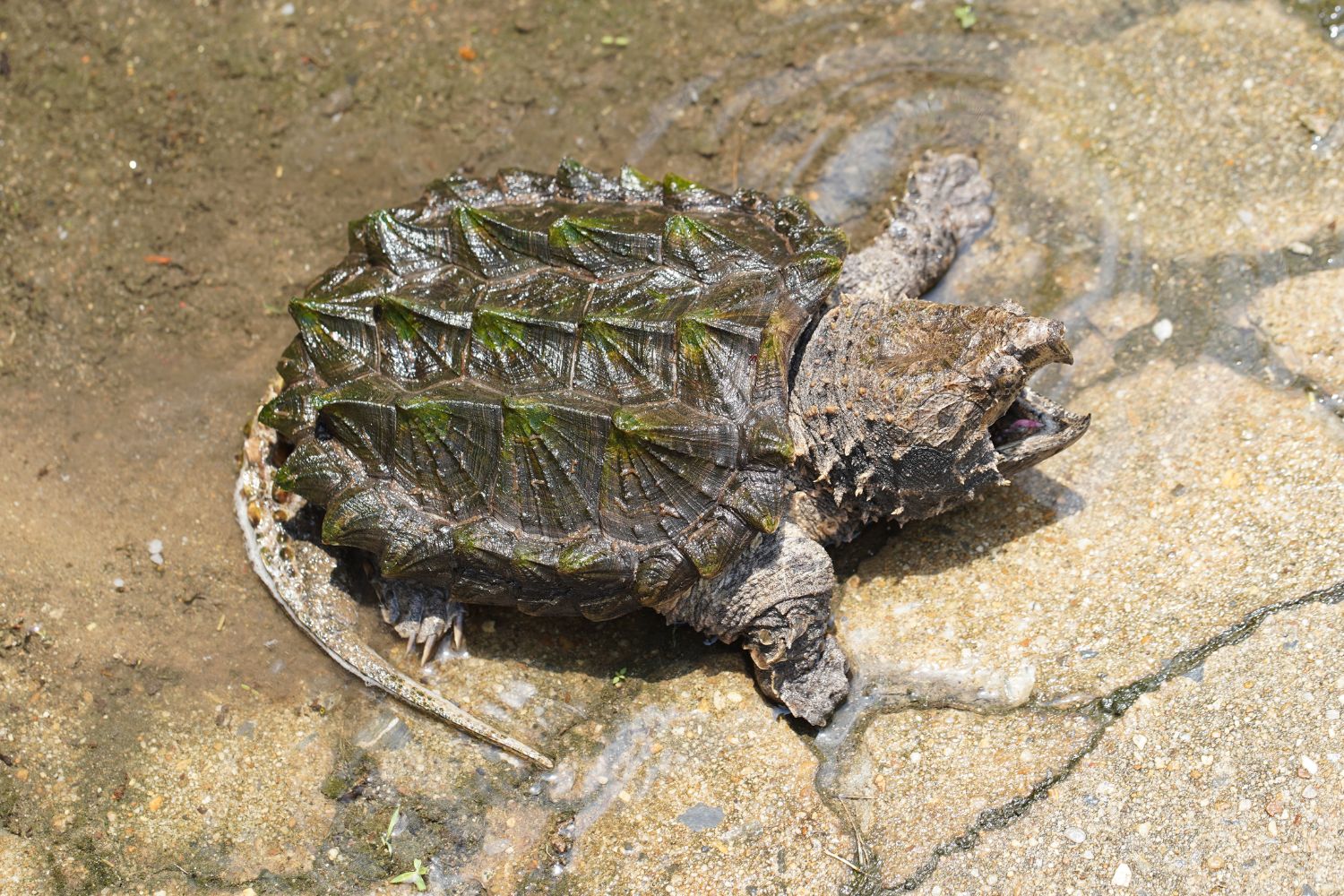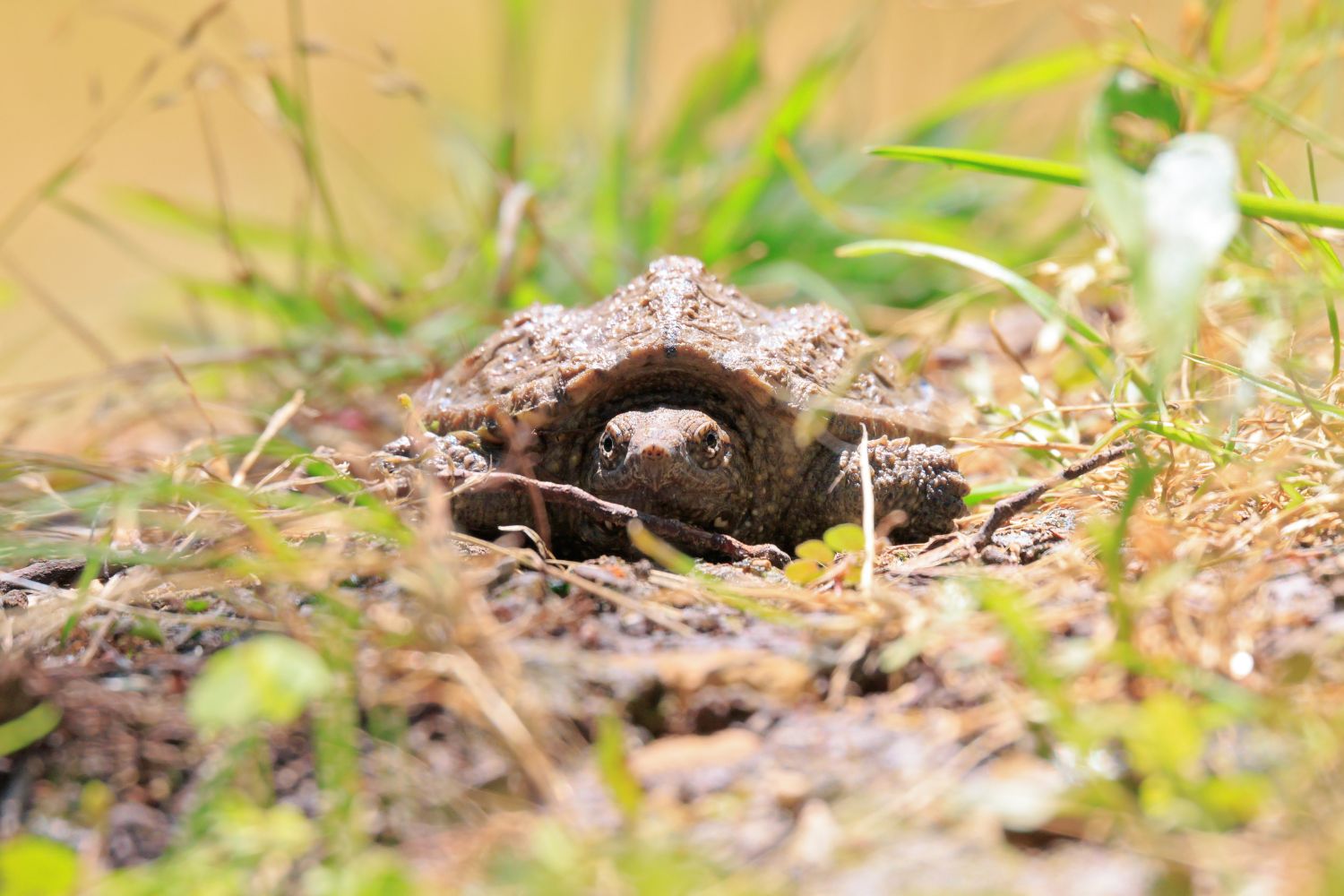
The alligator snapping turtle (Macrochelys temminckii) is one of the largest freshwater turtles in the world and the heaviest in North America. Adult males typically weigh between 70 and 113 kilograms (155 to 250 pounds), though exceptional individuals have been recorded weighing up to about 136 kilograms (300 pounds).

It has a thick shell with three distinct ridged spikes running along the back (carapace). These raised ridges and a camouflage of algae growing on its shell help it blend into murky waters. The turtle’s head is large and triangular with a strong, hooked beak. Its jaws are extremely powerful, capable of snapping through tough materials with ease. Unlike most turtles, it cannot fully retract its head into its shell, but it compensates with bony protective eyelids and fleshy, frilled skin that give it a prehistoric visage. This turtle’s coloration and texture help it hide exceptionally well.
PRESENTED BY AG1
The daily health habit you’ll actually stick with…
This time of year, it’s so easy for your daily routine to be thrown off.
When it starts getting dark before you’re home from work and the Halloween candy is taunting you, it’s important to find something that’s easy to do daily for your body.
With just one quick scoop every morning, you’ll get over 75 ingredients that help support your immune health, gut health, energy and help to close nutrient gaps in your diet.
Click here and you’ll get a free AG1 welcome kit with your first subscription including a:
✔️ FREE Flavor Sample Pack
✔️ FREE Bottle Vitamin D3+K2 Drops
✔️ FREE Canister + Shaker
It’s one of the easiest things you can do for your body every day.
*These statements have not been evaluated by the Food and Drug Administration.
Home in the Murk and Mud

Alligator snapping turtles are native to the southeastern United States, primarily inhabiting rivers, swamps, bayous, and lakes that drain into the Gulf of Mexico. They thrive in slow-moving, deep waters with plenty of submerged logs and vegetation. States like Louisiana, Florida, Georgia, and Texas are well-known for these turtles, and their range extends up the Mississippi River drainage into parts of the Midwest. Within these wetland habitats, alligator snappers spend most of their time submerged, lying motionless on the bottom. They prefer dark, turbid waters where their camouflage is most effective. Occasionally, they venture onto land (usually the females when nesting), but they are almost entirely aquatic.
PRESENTED BY 1440
Fact-based news without bias awaits. Make 1440 your choice today.
Overwhelmed by biased news? Cut through the clutter and get straight facts with your daily 1440 digest. From politics to sports, join millions who start their day informed.
Lurking With Jaws Wide Open

This turtle is an opportunistic carnivore and has an ambush hunting strategy. It will sit quietly on the riverbed with its jaws wide open, remaining perfectly still for minutes on end. On the floor of its bright pink mouth is a worm-like appendage on the tongue that it wiggles as a lure. Unsuspecting fish or frogs, thinking they’ve found a worm, swim straight into the turtle’s mouth only to be met with a lightning-fast snap of its jaws. This built-in fishing lure strategy is highly effective.

Beyond fish, alligator snapping turtles eat a variety of aquatic animals, including crayfish, mollusks, amphibians, and even other turtles if they can catch them. They are also known to scavenge carrion (dead animals) that sink to the bottom. These turtles are not active predators in the sense of chasing prey; instead, they conserve energy by allowing the food to come to them. They tend to be nocturnal or crepuscular (active at night or at dusk), which aligns with when many prey species are most active.

In terms of disposition, alligator snapping turtles are generally docile underwater and will usually remain still or swim away from humans. Unlike the more commonly encountered common snapping turtle (which can be feisty when provoked on land), alligator snappers rarely leave the water except to nest, so encounters with people are infrequent. However, if handled or threatened, their powerful bite can cause serious injury, so they deserve great respect, like every animal, and caution.
PRESENTED BY 1440
Daily News for Curious Minds
Be the smartest person in the room by reading 1440! Dive into 1440, where 4 million Americans find their daily, fact-based news fix. We navigate through 100+ sources to deliver a comprehensive roundup from every corner of the internet – politics, global events, business, and culture, all in a quick, 5-minute newsletter. It's completely free and devoid of bias or political influence, ensuring you get the facts straight. Subscribe to 1440 today.

Alligator snappers can live for many decades (often 50 to 100 years in captivity, and likely very long in the wild too). They grow slowly and mature late, which is common among long-lived reptiles. This strategy works well in stable environments with few predators; however, it can become a disadvantage when facing rapid environmental changes or human exploitation, as populations take a long time to recover.

Recently, what was once considered a single species of alligator snapping turtle is actually multiple distinct species. In 2014, scientists split the alligator snapping turtle into three species based on genetics and geography, one of which is the Suwannee alligator snapping turtle, unique to the Suwannee River in Florida. While they all look very similar, these separate species evolved in isolation in their respective watersheds over millennia.
Hatchlings, Heat, and Hope

Alligator snapping turtles reproduce slowly. Females lay just one clutch of eggs per year, and only a fraction of hatchlings survive to adulthood. Across much of their range, these turtles are listed as threatened or endangered, prompting conservation efforts to monitor and rebuild populations. Some programs raise hatchlings in captivity and release them once they are large enough to avoid most predators.

Like many reptiles, the sex of hatchlings depends on the temperature of the nest. Warmer nests tend to produce females, while cooler ones produce males. Since the mother does not return after laying her eggs, the environment alone determines the outcome. This makes future populations especially sensitive to changes in climate.

Their pace of life is slow in every sense. They move with heavy patience, grow at a crawl, and even their heart rate remains low, especially while underwater. Alligator snapping turtles can stay submerged for 40 to 50 minutes at a time, conserving energy in the quiet, oxygen-poor waters they call home.
Join RAWR SZN Premium
If you like this, you’ll like Premium even more.
Upgrade to PremiumPremium subscription includes:
- New posts every Tuesday, Thursday, and Sunday
- Bonus insights, rare behaviors, and deep dives
- Unlock full access to all archived posts
- Ad-free reading experience


